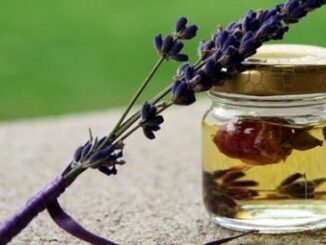
Caulophyllum Thalictroides
Common Names: Beechdrops, blueberry, blue ginseng, papoose root, squaw root, yellow ginseng.
Medicinal Part: Rootstock
Description: Blue cohosh is a perennial plant found in eastern North America, near running streams, around swamps and in other moist places. The fruit is a pea-sized, dark blue berry borne on a fleshy stock.
Properties and Uses: Anthelmintic, diaphoretic, diuretic, emmenagogue, oxytocic. Blue cochosh is used to regulate menstrual flow, particularly for suppressed menstruation. The Indians used it to induce labor, also for children’s colic and for cramps. Normally, it should be given in combination with other herbs indicated for the condition involved. Blue cohosh can be very irritating to mucous surfaces and can cause dermatitis on contact. Children have been poisoned by the berries.
Preparation and Dosage: Blue Cohosh should be used with medical supervision![1]
My midwife introduced me to blue cohosh during my first pregnancy. Traditionally, blue cohosh was used by Native Americans to induce labor. They would drink the tea for several weeks before childbirth to make the birth process swift and easy. North American doctors in the Electic or Physiomedical herbal tradition used blue cohosh to counter restlessness and pain during pregnancy and to reduce labor pains.[2] When used in conjunction with black cohosh, this herb tends to increase mild uterine contractions similar to Braxton-Hicks contractions, strengthening the uterine muscles in preparation for birth. However, due to the increased contractions, it should not be used until the ninth month of pregnancy.
For women who suffer from irregular menstrual cycles, or those preparing for pregnancy, blue cohosh can be a valuable tool. Certain properties of blue cohosh have been shown to increase blood flow to the uterus and to reduce muscle spams, which can provide welcome relief to those sufferers of severe menstrual cramps and even for those who suffer from arthritis.
“Blue cohosh contains several important minerals, including potassium, magnesium, calcium, iron, silicon and phosphorus. An active ingredient has been isolated from the herb called caulosaponin, a chemical that has been shown to increase blood flow to the uterus and reduce uterine contractions. Blue cohosh has been shown to be an emmenagogue, which means it helps to bring about menstruation, and to be an anti-spasmodic, or a substance which reduces muscle spasms.
General use
Blue cohosh is recommended as a general tonic for gynecological problems, specifically for the uterus. Blue cohosh is used for menstrual problems, such as amenorrhea (absence of menstrual cycles) and dysmenorrhea (irregularity of menstrual cycles), and to reduce the pain of menstrual cramps. During pregnancy, it can be used when there is a threat of miscarriage, and to reduce false labor pains. Used just before childbirth, it is reputed to ease pain and facilitate the birthing process. Blue cohosh’s anti-spasmodic properties enable it to be used in some cases of asthma, colic, and nervous coughs. Blue cohosh is also used to reduce pain in some cases of rheumatoid arthritis” .[3]
Blue Cohosh can also be used in conjunction with black cohosh and pennyroyal as an herbal abortion, but herbal abortions inherently carry many side effects and risks. The first thing to consider is that many herbal abortions are only marginally effective. For women attempting an herbal abortion, very few actually succeed.
When you attempt to terminate a pregnancy through the use of herbs, you are in essence poisoning yourself. In these cases, what women are doing is creating such high toxicity that their own body is unable to sustain the pregnancy. If an herbal abortion is to work, it is in essence working because it is poisoning the mother.
Another facet to consider with an herbal abortion is the real possibility of what you will do if it fails. The herbs you have taken (most specifically pennyroyal) will have undoubtedly affected the developing fetus. And very serious consideration must be given to a developing fetus that has been subjected to these toxins. Will you then carry the pregnancy to term despite the possible damage caused by these herbs, or seek a medical termination of the pregnancy?
I did find an excellent website that provides an in depth discussion of the use of blue cohosh as an herbal abortion, including dosage recommendations. For more information on this particular use of blue cohosh, I strongly suggest you check them out at: SisterZeus.Com.
——————————————————————————–
[1] The Herb Book, by John Lust, Benedict Lust Publications, 1974
[2] The New Age Herbalist, Richard Mabey with Michael McIntyre, Pamela Michael, Gail Duff, John Stevens, Collier Books, Copyright 1988 by Gaia Books Ltd., London.
[3] Blue Cohosh, Encyclopedia of Alternative Medicine, by Douglas Dupler
Unless otherwise stated, PONIREVO and/or its licensors DO NOT own any intellectual property rights in the website and material on the website. Majority of the site’s content has been scraped and auto posted by a third party artificial intelligence program —– PONIREVO Creation Team.
Proudly WWW.PONIREVO.COM
by Mary Welty



